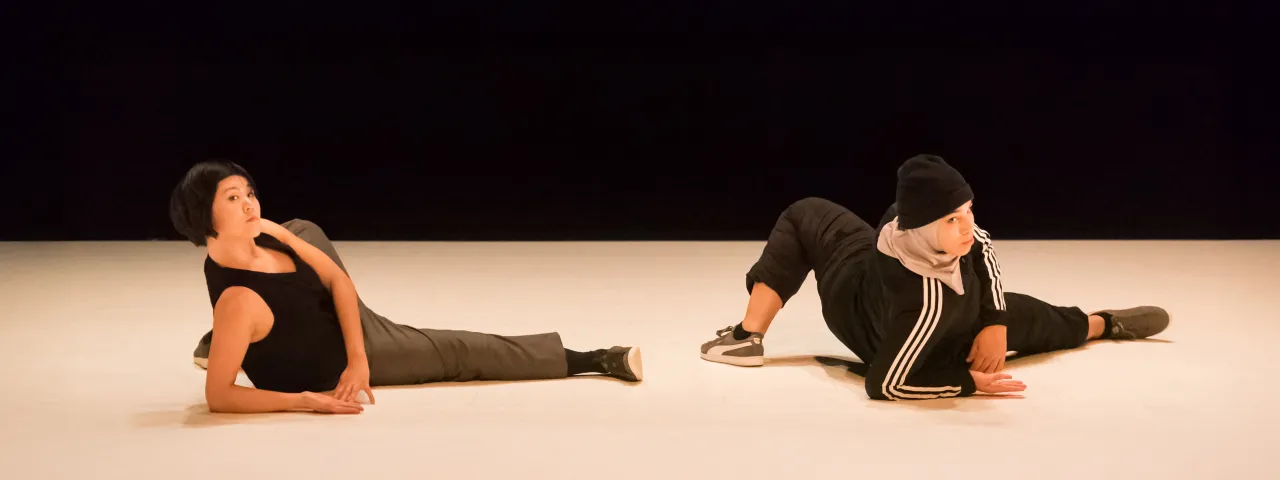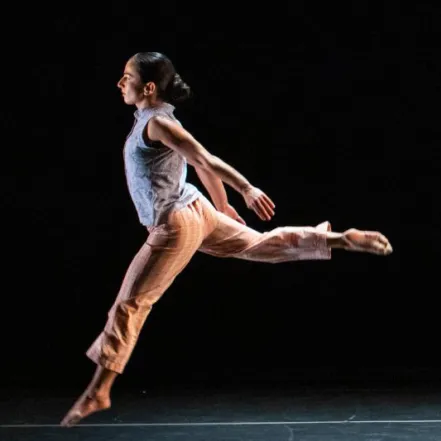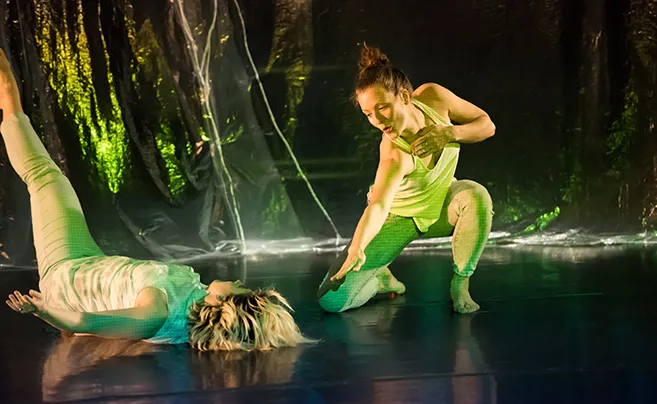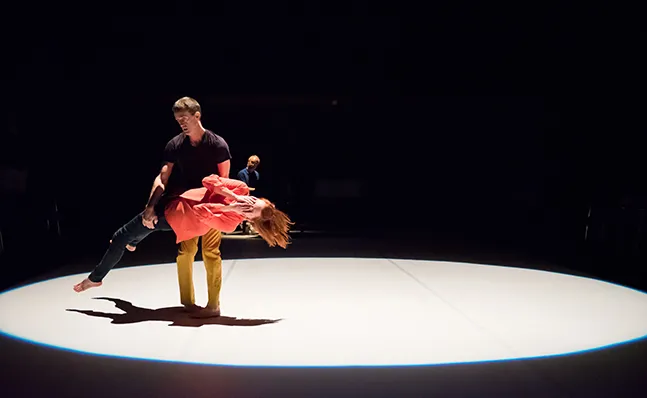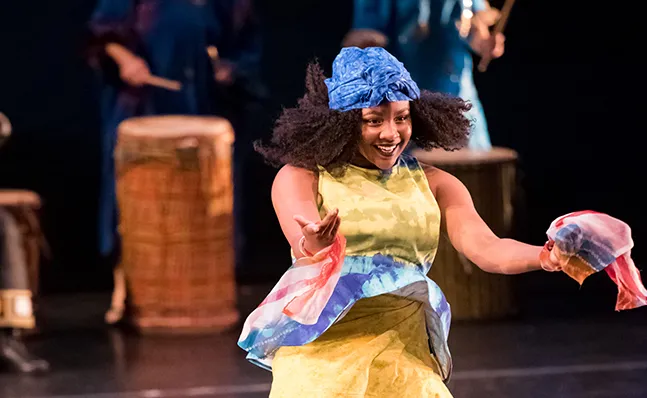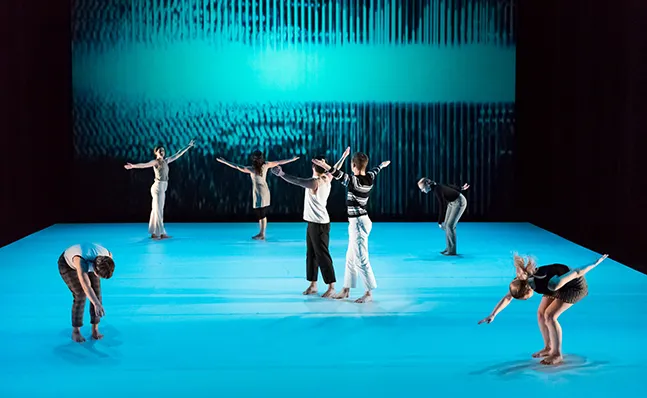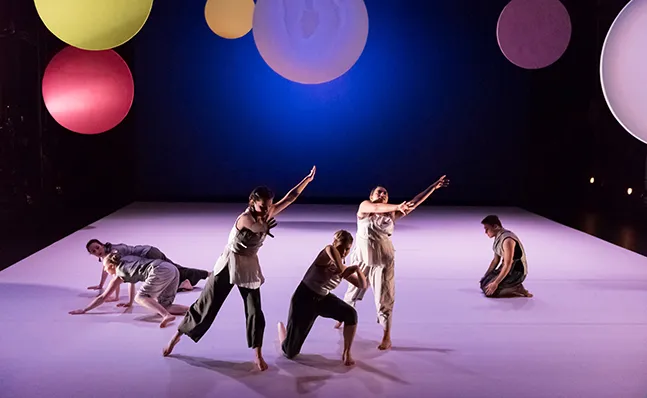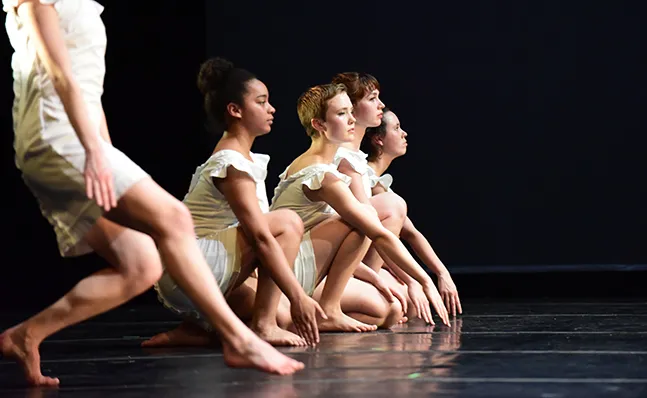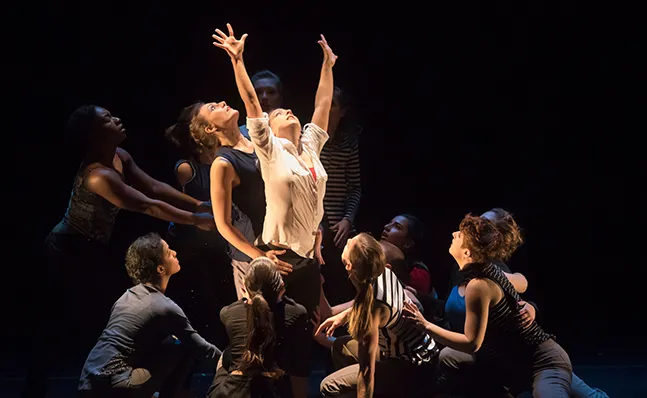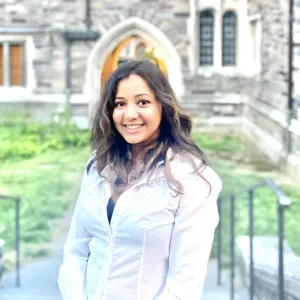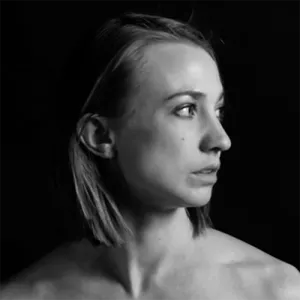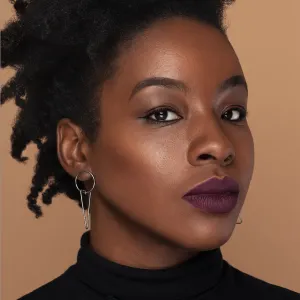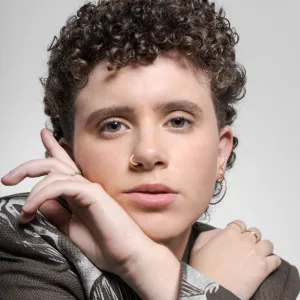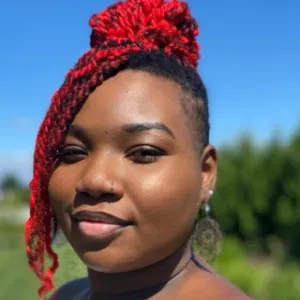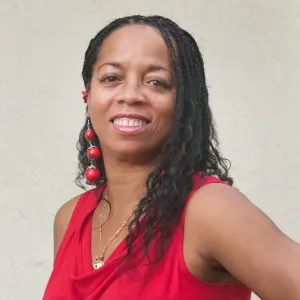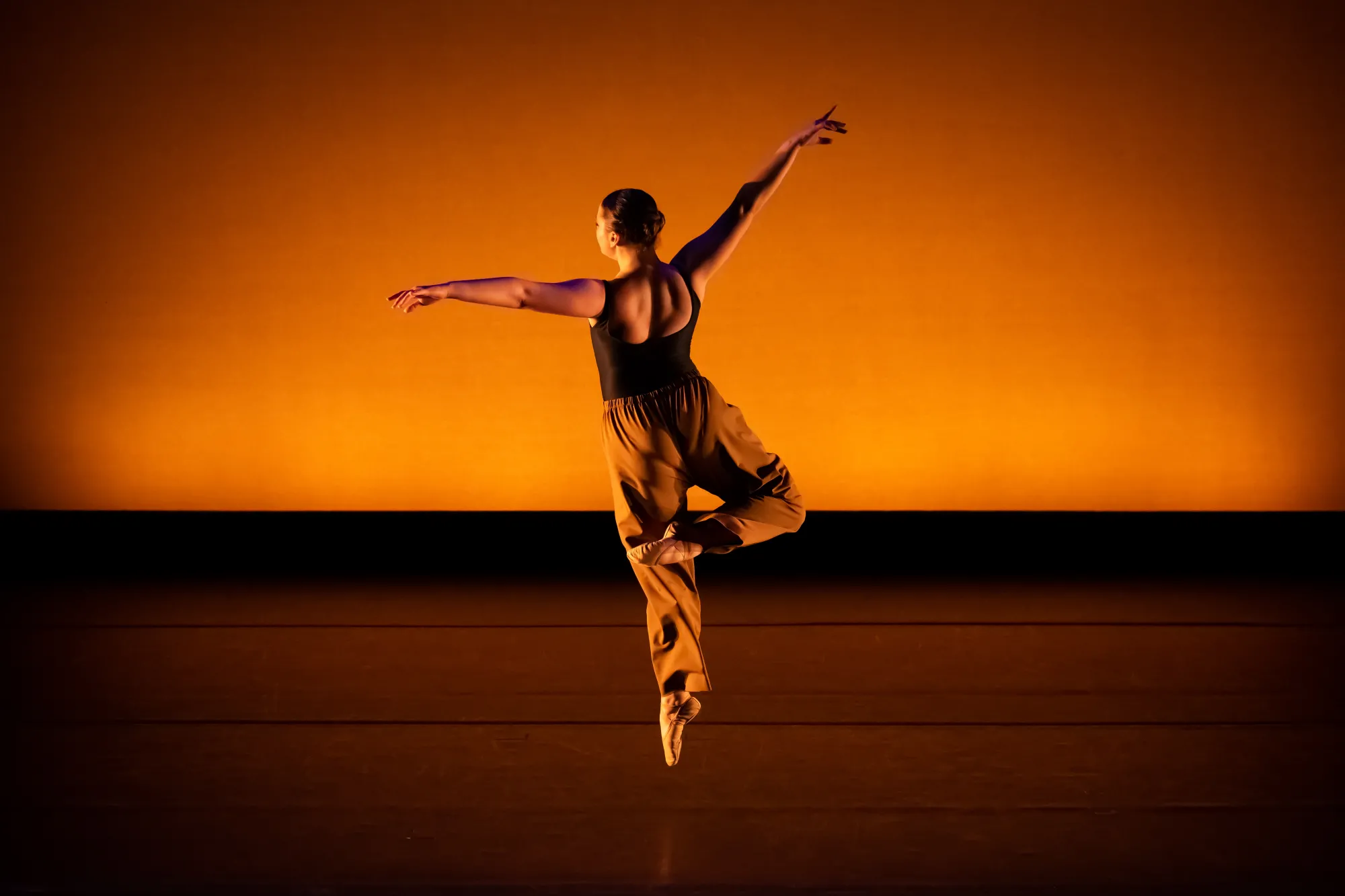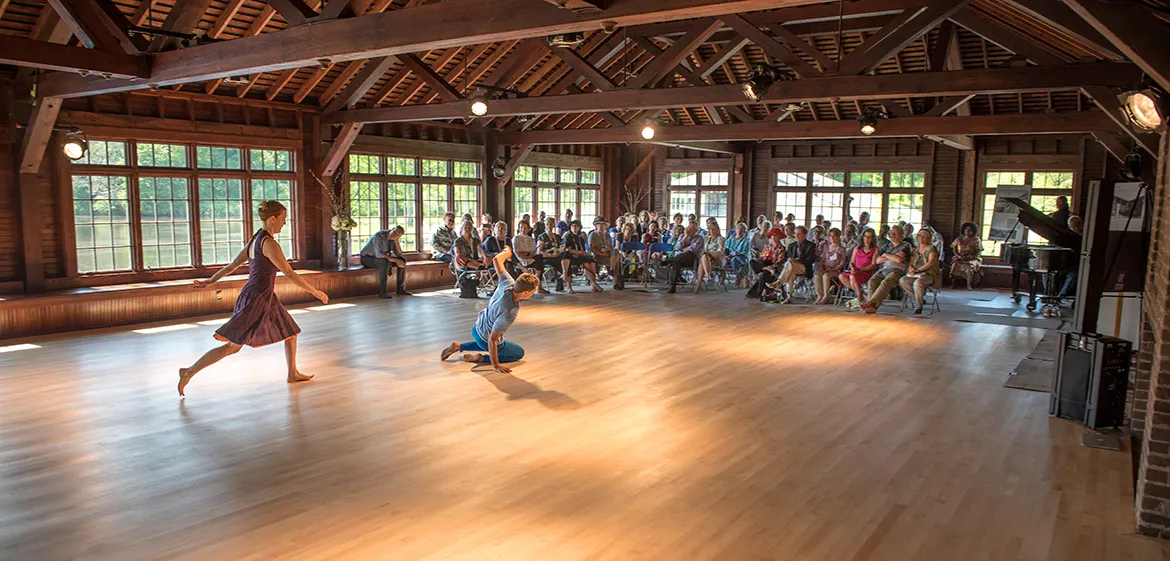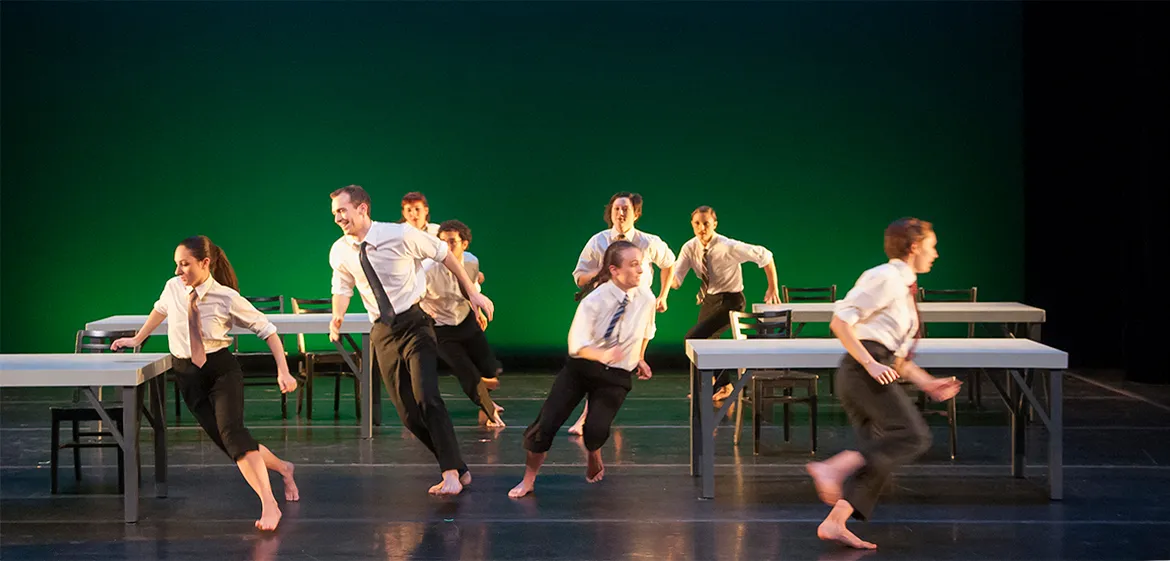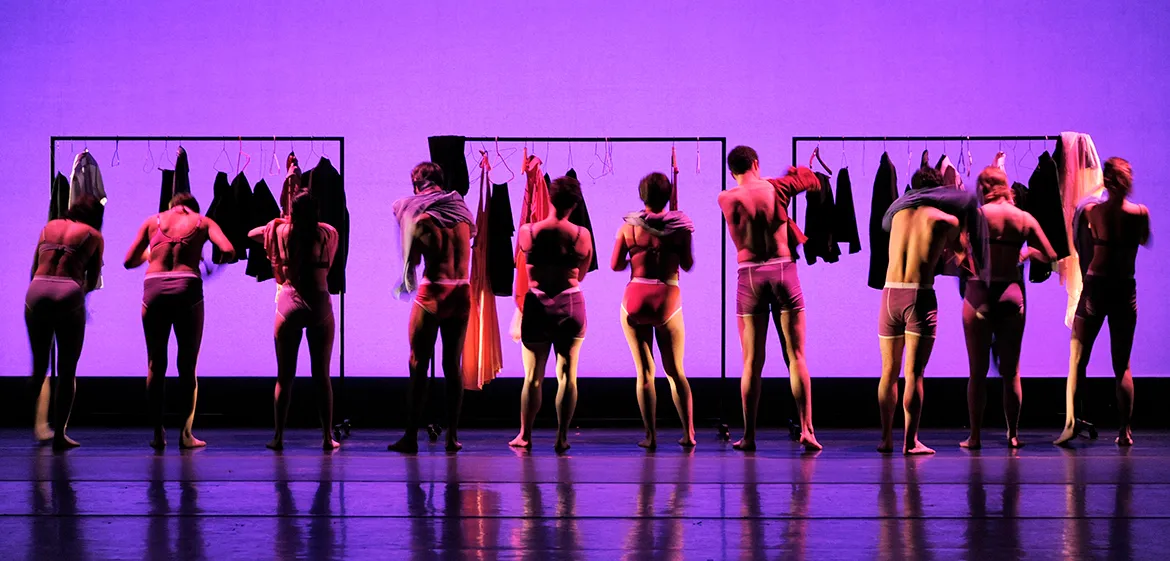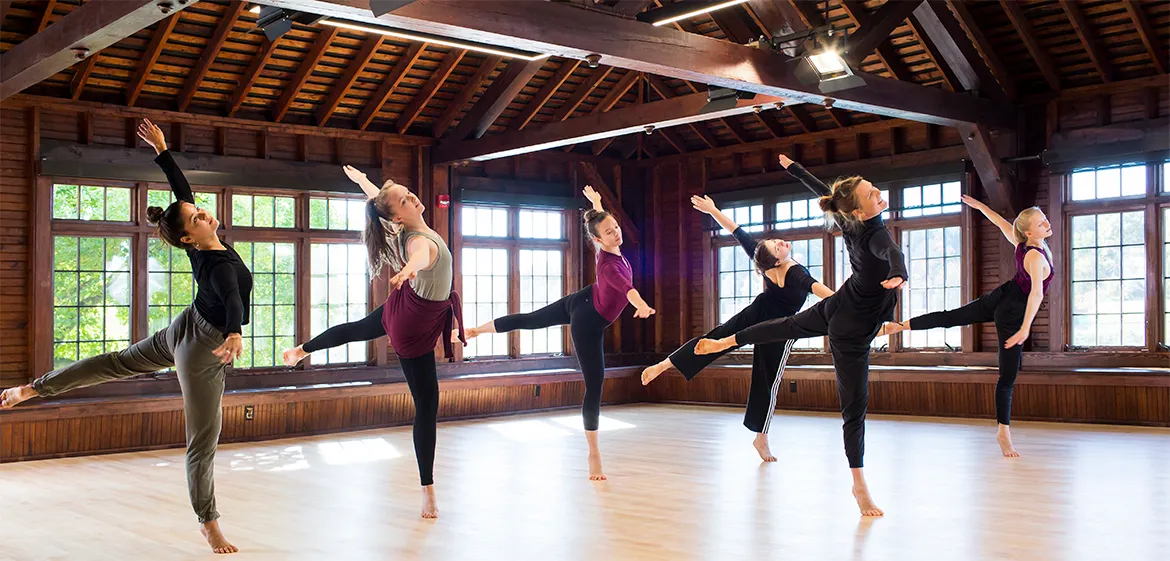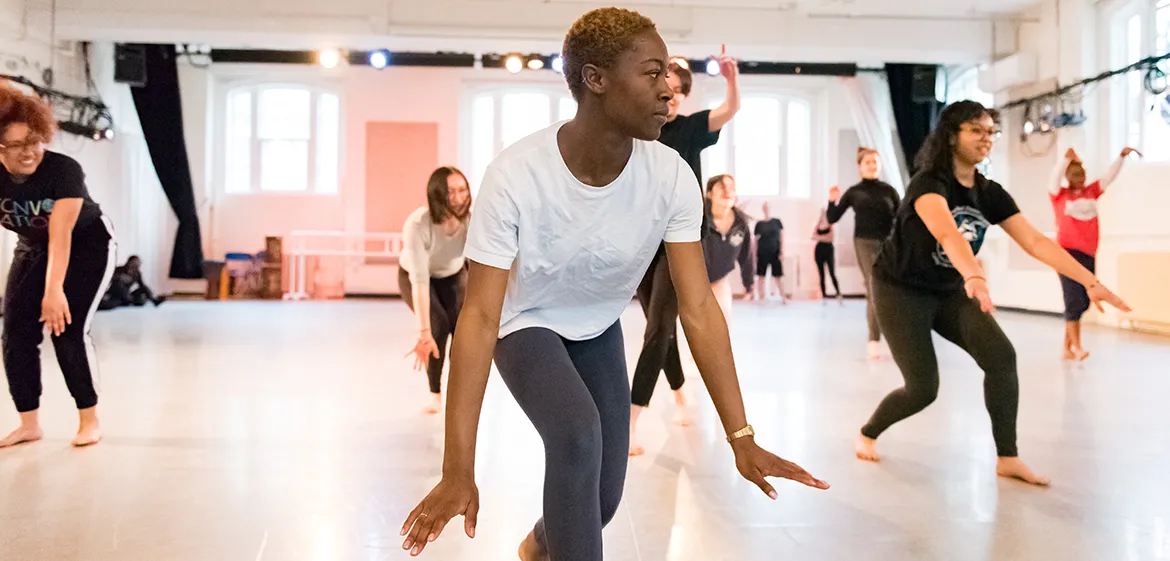Dance
In both the undergraduate and graduate programs, the faculty is dedicated to fostering each student’s unique talents as the student explores creative dance experiences. The Smith dance department is a member of the Five College Dance, a nationally recognized model for excellence in dance in higher education.
Dance at Smith
Smith's dance courses include contemporary modern, ballet, jazz, West African, dance history, dance composition, cultural studies, anatomy-kinesiology and advanced seminars in special topics. Most technique classes are taught with live music.
There is no mandatory core curriculum at Smith, and interdisciplinary studies are encouraged. Senior dance majors complete a thesis course and a choreographic or research project. Students are encouraged to study and perform at other schools in the Five College Dance Department; a fare-free bus system connects the campuses.
The dance department at Smith works out of four studios, two dedicated theaters and one informal theater. The Josten Library for the Performing Arts maintains an outstanding dance collection. There is a fully staffed costume and scene shop in the performing arts center.
There are four full-time faculty and a staff musician, eight graduate teaching fellows and several professional adjuncts and part-time musicians. The department sponsors regular master classes and special workshops, often led by members of such national touring dance companies as Mark Morris, Trisha Brown and Company and Urban Bush Women. Recent visitors have included guests from Ballet Theatre du Bourdeau, the Alvin Ailey Dance Company, the Royal Winnipeg Ballet and the Bill T. Jones/Arnie Zane Company. Master classes and workshops are often given by artists who are performing at the Fine Arts Center at the University of Massachusetts Amherst. A student-run dance company, Celebrations, was founded in 1983.
Five College Dance combines the programs of Amherst, Hampshire, Mount Holyoke and Smith colleges and the University of Massachusetts Amherst. The faculty operates as a consortium, coordinating curricula, performances and services.
The department, formed for the mutual benefit of all member institutions, supports a variety of philosophical approaches to dance and provides students an opportunity to experience a wide spectrum of performance styles and techniques. The faculty operates as one department, unifying its educational mission to include a well-balanced curriculum emphasizing a broad integration of technical, creative, historical and analytical aspects of dance; a wide variety of philosophical approaches to teaching; diverse course offerings enabling students to experience numerous performance styles, techniques and theoretical perspectives; and shared resources that provide a rich artistic and scholarly environment.
The collaborative structure of the department provides a large and diverse community of colleagues with whom to share pedagogic as well as artistic perspectives. Students may take a dance course on any of the five campuses and receive credit at their home institution, and course offerings are coordinated among the campuses to facilitate registration, interchange and student travel. Five College Dance is a nationally recognized model for excellence in dance in higher education.
Requirements & Courses
Goals for Majors in Dance
The major fosters comprehensive knowledge of the dance field and specialized skills in performance, choreography, theory, and production preparing students to pursue any of these areas through future careers. Students can major regardless of their dance background, whether in contemporary dance, hip-hop, ballet, or any other style. In addition to promoting liberal arts capacities, the major develops intelligence, perceptual awareness, creativity and imagination, cultural literacy, self-confidence in public performance, collaborative and interpersonal skills, in addition to project design, and management skills.
The capacities for the major in dance overlap and integrate throughout the curriculum. In the sections below, we articulate various aspects of the major and work of the department.
Dance Technique. By graduation, dance majors have engaged deeply with the physical practice of dance and possess the embodied knowledge and training that enables them to develop a range of movement skills and styles through courses and performing. Students develop a deep sense of physicality, articulation, expressivity, and the ability to adapt to emergent circumstances. We offer a wide range of dance technique courses, each of which provides unique movement and aesthetic opportunities for learning.
Composition and Creative Process. Creative research through choreography and dance repertory comprises a large part of the theory requirements for the major. This sequence of courses begins with the most basic study of dance composition—gesture, space, time, energy—and focuses on tools for finding and developing movement. The second and third level courses develop the fundamentals of formal choreography and expand work in the manipulation of spatial design, dynamics, phrasing, rhythm, content, and music. The movement materials that a student explores are not limited to any specific genre. This sequence also includes 4-credit repertory courses at the intermediate and advanced levels, in which students, as dancers, are participants in the creative process and development of faculty and guest artists’ choreography.
Dance History, Anthropology, and Aesthetics. Further study of dance is divided into dance aesthetics, dance anthropology, and dance history. Students learn to understand and conceptualize dance through these theoretical lenses and apply methods in dance history, anthropology, and aesthetics in their own research. They also acquire an interdisciplinary understanding of dance scholarship through the study of dance theory in dialogue with fields such as gender studies, performance studies, anthropology, cultural studies, architecture, theater, landscape studies, ecology, and film studies. The theory curriculum promotes dance literacy through a broad perspective that highlights the practice of this art both in the United States and globally, as a concert form and also an expression of popular culture, in a variety of social contexts and serving a vast array of artistic and cultural purposes.
Dance Science. The science of movement, perception, and action underlie all aspects of dancing. Dance majors acquire skills in these areas through mindful, directed practice, feedback from their instructors, and the study of anatomy, physiology, motor control and learning, and somatic research. Although this material is covered specifically in the scientific foundations of dance, it is integrated into our technique courses as well. Emphasis is placed not only on functional alignment, coordination, and the development of basic and higher level physical skills, it is also on the cognitive and emotional processes that clarify intention, expression, performance awareness, creative imagination, and perceptual attunement .
Music and Dance. The study of music for dance is the topic of a full course required for the major but is also an important aspect in all choreography and repertory courses. Understanding music and sound in terms of rhythm, melody, pitch, texture, acoustics, and phrasing is a skill majors develop. Additionally, they learn to understand the cultural, cognitive, and emotional effects of listening and making music. Students learn how to design sound in aesthetic ways that support their dances and in ways that respect the authorship of musicians, accompanists, and composers.
Goals for MFA in Dance
The mission of the MFA program is to foster the study of choreography and performance from a critical perspective that holds dance as a mode of research, means of expression, tool for interpretation of the human experience and practice of engagement with the world.
The program promotes the acquisition of choreographic tools, performance techniques, creative process methods, dance production skills and teaching methods informed by theories about dance, the body, aesthetics, design, creativity and pedagogy. The curriculum positions choreography and performance as forms of critical inquiry.
The program nurtures pluralist aesthetics by supporting students in the exploration of their own artistic interests and the development of an original voice in choreography. It prompts students to articulate their artistic identity as much in their choreographic production as in the analysis and self-assessment of their work in speech and writing.
It offers technique training in modern and postmodern dance, improvisation and contemporary ballet. Moreover, it comprises specialists in choreographic methods, creative process research, design thinking, music/sound for dance, dance, film and digital technology, theatrical production, kinesiology and somatic science, dance pedagogy, dance history, cultural studies, writing and qualitative research methods.
Composition, Creative Process and Dance Production. With choreography as its focus, students take four courses that foster the acquisition of thorough skills in creative process. Additionally, in their first year students give two public presentations of their choreography (the fall and spring grad events). In their second year, they work from summer to spring in the creation of an ambitious thesis project, leading to the presentation of the choreography in our state-of-the-art Theatre 14, with production support of professional level for lights, multimedia, sound, costumes, publicity and recording.
Performance. Live performance is at the heart of the MFA in dance and all graduate students in dance are expected to present mastery as performance artists. As performers, graduate students are cast in the choreography of faculty from Smith and the Five Colleges, having the opportunity to collaborate with their professors in the development of new work. The production of new choreography is a research-based, collaborative endeavor in which faculty and students work as creative partners.
Dance Pedagogy. Graduate students teach three technique courses per year, while receiving instruction in dance pedagogy in two required courses: Scientific Principles in the Teaching of Dance and The Pedagogy of Dance Technique. This combination of hands-on experience, coursework and mentoring is highly desirable in an master's program, as the MFA is a terminable degree in dance and many students pursue it with the goal of leading careers in academia.
Research and Theory. The program's emphasis is on dance research, theory and writing. Two required courses bolster this element of the curriculum: History and Literature of Dance: Research Methods and Landmarks and New Trends in Contemporary Dance. Additionally, two of the thesis’ components, Second Year Summer Research and Second Year Thesis: Production and Analysis, foreground research and writing through the completion of two in-depth papers that, combined, amount to 60 pages.
Dance Major
Requirements
Forty-eight credits
- Five technique courses (10 credits)
- At least two courses in one dance technique, including at least one at the intermediate level
- at least one course in a different technique
- Nine core courses (30 credits): DAN 151, DAN 171, DAN 241, DAN 252, DAN 272, DAN 287, DAN 200 (taken twice for a total of 2 credits), and DAN 399
- Two advanced courses (8 credits) from the following: DAN 305 (taken twice for a total of 4 credits), DAN 309, DAN 339, DAN 377ci, DAN 377sa, and DAN 400 (in choreography or theory)
Major Requirement Details
- One-credit courses do not count toward the technique requirements.
- Courses on physical conditioning for dancers do not count toward the technique requirements.
- A single level of a technique course may be taken for credit up to three semesters.
- Advanced technique courses require a placement exam.
- Dance majors are allowed 20 credits of technique courses for credit toward the degree. After 20 credits, courses appear on the transcript with a grade marked with an asterisk, do not count towards the 128 credits required for the degree, are not averaged into the GPA, and are not included in cumulative totals. Dance majors who do not complete the major will forfeit their surplus credits. If a student wishes to receive credit for technique courses beyond the limit, they should speak to a faculty member about designing a special studies course.
- The dance department coordinates its course offerings with the other member programs of Five College Dance. In consultation with their advisers, students can plan on taking courses required for the major on those other campuses.
- Students may substitute no more than one course from another department at Smith to fulfill a dance major requirement. Substitute courses must be approved by the dance department faculty.
- The S/U grading option is not allowed for courses that count toward the major.
Honors
Please consult the director of honors or the departmental website for specific requirements and application procedures.
Dance Minor
Requirements
Twenty-seven credits
- Six required courses (21 credits)
- DAN 151
- DAN 171
- DAN 241
- DAN 272
- DAN 287
- DAN 200
- Three technique courses (6 credits)
Minor Requirement Details
- One-credit courses do not count toward the technique requirements.
- Courses on physical conditioning for dancers do not count toward the technique requirements.
- Dance minors are allowed 12 credits of technique courses for credit toward the degree. After 12 credits, courses appear on the transcript with a grade marked with an asterisk, do not count towards the 128 credits required for the degree, are not averaged into the GPA and are not included in cumulative totals. If a student wishes to receive credit for technique courses beyond the limit, they should speak to a faculty member about designing a special studies course.
Course Information
Dance technique courses may not be audited; registration is mandatory.
Students may register for the same technique course up to three times for credit.
Dance majors are allowed 20 credits of technique courses for credit toward the degree. Nonmajors are allowed 12 credits of technique for credit toward the degree. After these credit limits, courses appear on the transcript with a grade marked with an asterisk, do not count towards the 128 credits required for the degree, are not averaged into the GPA and are not included in cumulative totals. Students must continue to register for all technique courses. If a student wishes to receive credit for technique courses beyond the limit, they should speak to a faculty member about designing a special studies course.
Dance majors who do not complete the major will forfeit their surplus credits.
For a list of courses offered on the other four campuses of the consortium, visit the website of Five College Dance Department. www.fivecolleges.edu/academics/dance
Courses
DAN 101sf Topics: Dance Studio-Strength and Flexibility through Movement (1 Credit)
This course provides students with a practical and theoretical understanding of the relationship between the strength, flexibility and mobility of the body. Through experiential methods students learn how the connective tissues of the body function both as an interconnected web which facilitates movement, alignment and coordination, as well as proprioception. Students develop an individualized practice throughout the semester drawing from various movement systems and dance training methods. Students examine the relationship between strength, flexibility and agility as applied to dancing. Restrictions: DAN 101 may be taken for credit a total of 3 times with different topics. Enrollment limited to 40. Arts
Fall, Spring, Variable
DAN 113fn Topics in Beginning Contemporary Dance-Fundamentals (2 Credits)
Restrictions: DAN 113 may be taken for credit a total of 3 times with different topics. Enrollment limited to 30. Arts
Fall, Spring, Variable
DAN 113mo Topics in Beginning Contemporary Dance-Introduction to Modern (2 Credits)
Restrictions: DAN 113 may be taken for credit a total of 3 times with different topics. Enrollment limited to 30. Arts
Fall, Spring, Variable
DAN 114 Beginning Contemporary Dance 2 (2 Credits)
For students who have taken Beginning Contemporary Dance or the equivalent. Enrollment limited to 25. Arts
Spring
DAN 119 Beginning Contact Improvisation (2 Credits)
A duet form of movement improvisation. The technique focuses on work with gravity, weight support, balance, inner sensation, outer awareness and touch, to develop spontaneous fluidity of movement in relation to a partner. May be repeated once for credit. Enrollment limited to 25. Arts
Fall, Spring
DAN 120 Beginning Ballet 1 (2 Credits)
Beginning study of the basic principle and vocabularies of classical ballet. Class covers both Barre and Center. Emphasis is placed on body alignment, the development of whole-body movement and musicality. The basics of more advanced steps, from turns to jumps, are introduced. Primary concepts such as outward rotation, weight shifts and physical safety are emphasized. Two to three semesters are recommended at the beginning level before advancement to Intermediate levels. May be repeated up to three times. Enrollment limited to 25. Arts
Fall, Spring
DAN 121 Beginning Ballet 2 (2 Credits)
A continuation of DAN 120. Beginning study of the basic principle and vocabularies of classical ballet. The class is composed of two parts: Barre and Center. Emphasis is placed on body alignment, the development of whole-body movement and musicality. The basics of more advanced steps, from turns to jumps, are introduced. Primary concepts such as outward rotation, weight shifts and physical safety are emphasized. Two to three semesters are recommended at the beginning level before advancement to Intermediate levels. Prerequisite: DAN 120 or equivalent. May be repeated up to three times. Enrollment limited to 25. Arts
Fall, Spring
DAN 130 Beginning Jazz Dance (2 Credits)
Enrollment limited to 30. Arts
Fall, Spring, Annually
DAN 133 Dance for Every Body (2 Credits)
This course serves as an accessible dance course for all students interested in dance, regardless of ability and dance experience. Throughout the semester, students are introduced to a variety of dance forms and approaches (contemporary dance, salsa, jazz/funk, improvisation). The course promotes the development of dancing skills, aesthetic appreciation, community connection and cultural literacy. In these studio classes, students learn dance techniques while cultivating physical competencies, artistic creativity and bodily expressivity as a part of a community experience. Assignments, class discussions and movement material are designed to foster critical analysis of contemporary issues related to the interaction of dance and society. Enrollment limited to 25. Arts
Fall, Spring, Variable
DAN 137 Beginning Tap (2 Credits)
This course is structured to introduce students to the art of tap dance. This course focuses on developing technical and improvisational skills. In addition, it also delves into the historical and cultural context of the art form. Specifically, students hone their practice of technical building blocks, such as toe taps, heel drops, shuffles, pullbacks, and ball changes. Students also experiment with various time signatures, polyrhythms, tones, volumes, and tempos to familiarize themselves with the complexities possible in the form. Enrollment limited to 30. Arts
Fall, Spring, Variable
DAN 138 Dance in Musical Theatre (2 Credits)
This course explores the creation and performance of dance as it relates to musicals and storytelling in theater. Students practice applicable dance techniques and choreographic principles, gaining a hands on understanding of dance in musicals. The course embraces a diversity of styles and definitions of musicals. Instructors build upon their own training to teach material in the lineage of one or more dance forms—e.g., jazz, tap, ballet, modern dance, hip hop—that feature in musicals for the stage and the screen. The course situates its topic in relevant historical and cultural contexts. Open to students at all levels of experience. Enrollment limited to 30. Arts
Fall, Spring, Variable
DAN 141bw Topics in Dance Forms-Bollywood (2 Credits)
This course provides a comprehensive study of Bollywood dance, encompassing fundamental footwork, grooves, rhythm patterns and expressive hand gestures. Students delve into the cultural significance of Bollywood dance, cinema and music, gaining insights into societal changes over time. Additionally, the course explores folk dances from various Indian states, such as Rajasthan, Punjab and Gujarat, enriching students' understanding of regional dance traditions. Restrictions: DAN 141 may be taken for credit a total of 3 times with a different topic. Enrollment limited to 30. (E) Arts
Fall, Spring, Annually
DAN 141fl Topics in Dance Forms-Flamenco (2 Credits)
This course is a comprehensive introduction to flamenco, a product of Spain's blended Andalusian culture. Principles of flamenco musicality and structure are combined with the foundations of flamenco dance technique. Students study colocación (placement), estilización (stylization), posturas (postures), brazeo (armwork), floreo (handwork), vueltas (turns), taconeo (footwork), compás (phrasing), palmas (rhythmic clapping), jaleo (words of encouragement) and letras (verses). These skills are applied to choreographic studies and improvisation in a juerga (social) setting. Students use their knowledge to build a patada (a short dance) in one of two styles - bulerías or tangos. Sturdy heeled shoes are required. Restrictions: DAN 141 may be taken for credit a total of 3 times with a different topic. Enrollment limited to 30. Arts
Fall, Spring, Variable
DAN 142bc Beginning AfroCuban (2 Credits)
This course offers an exciting exploration of Cuban dance, focusing on styles deeply connected to Black identity and culture. Students dive into the rich history, spirituality, and artistic expressions of AfroCuban dance forms rooted in African ethnic groups like the Bantu, Yoruba, and Fon. These traditions have profoundly shaped Latin American dance and continue to influence today's global culture. Through hands-on learning, students experience the intricate rhythms and dynamic movement patterns that have transcended borders and time, merging into contemporary popular culture. Get ready to not only study these dances but also move to their vibrant beats, gaining a deeper understanding of their impact on identity and expression. Features live drummers. Restrictions: DAN 142 may be taken for credit a total of 3 times with a different topic. Enrollment limited to 30. Arts
Fall, Spring, Variable
DAN 142wa Topics in Dance Forms of the African Diaspora: West African Dance (2 Credits)
This course introduces West African dance, music and song as a traditional mode of expression in various West African countries. It emphasizes appreciation and respect for African culture and its profound influence on American culture and art. Restrictions: DAN 142 may be taken for credit a total of 3 times with a different topic. Enrollment limited to 30. Arts
Fall, Spring, Variable
DAN 143ka Topics in Indian Dance-Kathak (2 Credits)
Highly expressive and technically precise, Kathak is a renown genre of Indian dance performed across the world—at once a symbol of North Indian culture and a transnational practice of the Indian diaspora. With roots in Indian temples and influenced by Middle Eastern culture, Kathak blends dance, drama and music to tell mythological stories. This course introduces elements of Kathak technique, including its signature percussive footwork and symbolic hand gestures (mudras). It fosters knowledge of Kathak’s history and cultural context, teaching the technique in dialogue with Indian music, philosophy and mythology. No previous experience necessary. Restrictions: DAN 143 may be taken for credit a total of 3 times with a different topic. Enrollment limited to 30. Arts
Fall, Spring, Variable
DAN 144 Tango I (2 Credits)
Argentine Tango is the sensual and elegant social dance of the city of Buenos Aires, which is experiencing a worldwide revival. Class includes the movements, the steps, the history and anecdotes about the culture of Tango. The class covers traditional and modern forms. All dancers learn lead and follow, so you do not need a partner. May be taken twice for a total of four credits. Enrollment limited to 40. Arts
Fall, Spring, Variable
DAN 146 Beginner Hip Hop Dance (2 Credits)
Hip hop is a popular form of Afro-diasporic cultural production and, for many, a lifestyle. In this studio course for beginner dancers, students learn movements from the poppin', lockin', house and breakin’ dance techniques. This study of movement vocabulary is contextualized in analyses of hip hop’s history, culture and current trends. May be taken three times for a total of six credits. Enrollment limited to 30. Arts
Fall, Spring
DAN 149 Salsa Dance I (2 Credits)
This course introduces the students to the New York mambo style of salsa (beginner-level). It also covers elements of the Cuban style of salsa, representative of an Afro-Caribbean dance aesthetic. Students master different variations of the salsa basic step, as well as turns, connecting steps and arm work. They learn how to dance in couples and also in larger groups known as ruedas (wheels). Toward the end of the semester, students are able to use their salsa vocabulary as basis for improvising and choreographing salsa combinations. We approach salsa as a social dance form expressive of Caribbean culture and Latino culture in the United States. Most of the work takes place in the studio but, in addition to learning the dance, students read selected articles and watch documentaries about the dance genre. Class discussions and brief writing assignments serve as an opportunity to reflect on salsa’s history and culture. Enrollment limited to 30. Arts
Fall, Spring, Variable
DAN 151 Elementary Dance Composition (4 Credits)
Introductory study of dance composition, including movement research, spatial design, rhythmic phrasing, musical forms and performance. Enrollment limited to 12. Arts
Spring
DAN 171 Dance History: Political Bodies From the Stage to the Page (4 Credits)
This course excavates the artistic, social and cultural trends that have driven the histories of ballet, jazz dance, modern dance and postmodern dance throughout the 20th & 21st centuries. The course looks critically at artists such as Isadora Duncan, Rudolf Laban, George Balanchine, Martha Graham, Katherine Dunham, Alvin Ailey, Anna Halprin, Pina Bausch and Bill T. Jones. Through readings, discussions, dance viewings, movement activities and sessions in the Museum of Art, Josten Library and Sophia Smith Collection, students examine how notions of race, nationality, gender, sexuality and political ideology inform dance. Students conduct historical research on a topic of their choice. Enrollment limited to 20. Arts; Historical Studies
Fall, Spring
DAN 200 Dance Production (1 Credit)
A laboratory course based on the preparation and performance of department productions. Students may elect to fulfill course requirements from a wide array of production related responsibilities, including stage crew. It may not be used for performance or choreography. Students who wish to register for two credits in the same semester should register for two separate sections of DAN 200. Restrictions: May be taken four times for credit, with a maximum of two credits per semester. Arts
Fall, Spring
DAN 202 Strength and Flexibility through Movement Intermediate (2 Credits)
This course provides students with a practical and theoretical understanding of the relationship between strength, flexibility and mobility of the body. Through experiential methods students learn how the connective tissues of the body function as an interconnected web which facilitates movement, alignment, coordination and proprioception. Students develop an individualized practice throughout the semester drawing from various movement systems and dance training methods. The course examines the relationship between strength, flexibility and agility as applied to dancing. This course supports students training in dance and other movement forms. Students learn anatomical connections within the musculo-skeletal system and apply them to movement practice. Enrollment limited to 25. Arts
Spring
DAN 207 Intermediate Repertory (2 Credits)
This course offers an in-depth exploration of aesthetic and interpretive issues in dance performance. Through experiments with improvisation, musical phrasing, partnering, personal imagery and other modes of developing and embodying movement material, dancers explore ways in which a choreographer’s vision is formed, altered, adapted and finally presented in performance. May be taken three times for credit. Audition required. Instructor permission required. Arts
Fall
DAN 210 Hybrid Technique: The Modern Dance to Ballet Continuum (2 Credits)
This technique course emphasizes that dance genres are not isolated in themselves. Each style has a variety of influences. The course physically explores and embodies both the similarities and differences between two forms of dance and the variety of movement aesthetics and possibilities created when ideas and tools from both forms are present in the body simultaneously. The course also teaches how these two genres can support each other and enrich a dancer's unique movement qualities and sequences. Prerequisite: Modern or Contemporary Technique at the Advanced Beginner level. Enrollment limited to 35. Arts
Fall, Spring, Variable
DAN 215 Intermediate Contemporary Dance 1 (2 Credits)
Prerequisite: Any topic of DAN 113 or previous dance experience. Enrollment limited to 30. Arts
Fall
DAN 216 Intermediate Contemporary Dance 2 (2 Credits)
May be taken three times for a total of six credits. Prerequisite: DAN 215 or equivalent. Enrollment limited to 30. Arts
Spring
DAN 219 Intermediate Contact Improvisation (2 Credits)
A duet form of movement improvisation. The technique focuses on work with gravity, weight support, balance, inner sensation, outer awareness, and touch, to develop spontaneous fluidity of movement in relation to a partner. Prerequisite: at least one previous dance technique course or equivalent. Enrollment limited to 25. Instructor permission required. Arts
Fall, Spring, Annually
DAN 222 Intermediate Ballet 1 (2 Credits)
Intermediate study of the principle and vocabularies of classical ballet. Class covers both Barre and Center. The primary concepts from the beginning study are developed: body alignment, development of whole-body movement, musicality and embodiment of performance style. All types of turns and various jumps are developed, both petit and grand allegro. Two to three semesters at the intermediate level are recommended before auditioning for Advanced levels. Prerequisite: DAN 121 or equivalent. May be repeated up to three times. Enrollment limited to 25. Arts
Fall
DAN 223 Intermediate Ballet 2 (2 Credits)
A continuation of DAN 222. Intermediate study of the principle and vocabularies of classical ballet. Class covers both Barre and Center. The primary concepts from the beginning study are developed: body alignment, development of whole-body movement, musicality and embodiment of performance style. All types of turns and various jumps are developed, both petit and grand allegro. Two to three semesters at the intermediate level are recommended before auditioning for Advanced levels. Prerequisite: Previous dance experience. May be taken up to three times. Enrollment limited to 30. Arts
Spring
DAN 227 Intermediate Pointe Technique (1 Credit)
This course is an intermediate study of contemporary pointe technique. All students are assumed to have an appropriate level of ballet technique (as covered in the FCDD's ballet courses or the equivalent). The FCD Advanced Placement status is not required however, all students must be concurrently registered for a related two credit technique class and are required to be at the intermediate level in that technique. May be taken up to three times. Meets with DAN 327. Enrollment limited to 30. Arts
Fall, Spring, Annually
DAN 237 Intermediate Tap (2 Credits)
This course is structured to deepen students' relationship to the art of tap dance. The course focuses on refining technical and improvisational skills. In addition, the course delves into the historical and cultural context of the art form. Specifically, students hone their practice of technical building blocks e.g. shuffles, paddle-and-rolls, pull backs, rhythm turns, and wings. Students also experiment with various time signatures, polyrhythms, tones, volumes, and tempos to familiarize themselves with the complexities possible in the form. Lastly, students learn sections of choreography from the traditional tap dance repertoire. Prerequisite: DAN 137. Enrollment limited to 15. Arts
Fall, Spring, Variable
DAN 241 Scientific Foundations of Dance (4 Credits)
An introduction to selected scientific aspects of dance, including anatomical identification and terminology, physiological principles, and conditioning/strengthening methodology. These concepts are discussed and explored experientially in relationship to the movement vocabularies of various dance styles. Enrollment limited to 30. Arts
Fall, Spring, Alternate Years
DAN 242 Dance Forms of the African Diaspora Intermediate (2 Credits)
This studio course offers intermediate level technique training in any of the dance forms from Africa and the African Diaspora. The physical study of the form is contextualized socially, culturally and historically, favoring an interdisciplinary perspective. Through the course, students approach the study of dance as a catalyst for cultural empowerment and social change. Enrollment limited to 30. Arts
Spring
DAN 245 Intermediate Afro-Modern (2 Credits)
This course focuses on developing modern dance technique, specifically técnica cubana as conceptualized by Cuban choreographers Ramiro Guerra and Eduardo Rivero. This technique integrates elements from Graham, Cunningham, Limon, ballet, and Afro-Cuban dance, emphasizing improvisation and expressive breathing techniques. Through this course, students enhance their performance and creative skills by exploring various movement qualities, such as spine articulation, body isolations, awareness of gravity, and complex polyrhythms. The ability to take risks and work with others to investigate and analyse movement in depth from anatomical concepts as well as to explore one's own maximum capabilities are fundamental and supported in this course. Enrollment limited to 30. (E) Arts
Fall, Spring, Variable
DAN 246 Intermediate Hip Hop (2 Credits)
This course journeys through time and allows students to experience in their own bodies the evolution of Hip hop from its social dance roots to the contemporary phenomenon of commercial choreography that Hip hop has become. Using film and text in addition to studio work, this class creates a framework from which to understand and participate in the global culture of Hip hop dance. May be taken twice for a total of four credits. Enrollment limited to 30. Arts
Fall, Spring, Variable
DAN 252 Intermediate Dance Composition (4 Credits)
Course work emphasizes dance making, improvisation, and performance through generating and designing movement based studies and one fully realized performance project. Various devices and approaches are employed including motif and development, text and spoken language, collage and structured improvisation. Enrollment limited to 10. Instructor permission required. Arts
Fall
DAN 272 Dance Anthropology: Performed Identities and Embodied Cultures (4 Credits)
What are social functions of dance? How does the body signify culture? How does movement articulate identities? What forms of knowledge do dance anthropologists produce, and how? Through theories of performance and embodiment, this course illuminates the relationships between self, body, culture, and society. It discusses the nature of fieldwork and ethnographic research in dance, critically examining how contemporary ethnographers negotiate the historical relationship between anthropology and coloniality. The course highlights ethnographies of dance forms from the Americas, Africa, Asia, the Middle East, and Europe. Students conduct a fieldwork project of their choice, engaging in participant observation and fieldnote writing. Enrollment limited to 20. Arts; Social Science
Spring, Variable
DAN 287 Analysis of Music from a Dancer's Perspective (4 Credits)
A primary goal is development of the ability to focus on subtle details in music while dancing, teaching, choreographing, or performing. Dancers cultivate an open-mind and skills for imagining many relationships between dance and music. Students improvise music, make up songs, translate choreography into music, and dance with music from various cultures and historical periods. The course emphasizes rhythm, terminology, and categories, meaning in music, and strategies for finding music. Students listen to varied musical styles and paradigms, formulate statements about music, study ethical questions about music and musicians, and distinguish between recorded and live music. Enrollment limited to 12.
Fall, Spring, Alternate Years
DAN 300ct Topics in Dance Technique and Performance-Contemporary Trends (1 Credit)
This studio dance course offers a series of contemporary dance technique master classes with Smith MFA teaching fellows and other dance artists. It is designed to augment students' on-going dance training. Through this course students engage in a wide range of approaches and material in the contemporary dance realm. Each week is a “deep-dive” into a different aesthetic and artistic philosophy. It aims to introduce students to a variety of perspectives on dance and its place in our culture.
Fall, Spring, Variable
DAN 305 Advanced Repertory (2 Credits)
This course offers an in-depth exploration of aesthetic and interpretive issues in dance performance. Through experiments with improvisation, musical phrasing, partnering, personal imagery and other modes of developing and embodying movement material, dancers explore ways in which a choreographer’s vision is formed, altered, adapted and finally presented in performance. May be taken twice for a total of 4 credits. Audition required. Instructor permission required. Arts
Fall
DAN 309 Advanced Repertory (4 Credits)
This course offers an in-depth exploration of aesthetic and interpretive issues in dance performance. Through experiments with improvisation, musical phrasing, partnering, personal imagery and other modes of developing and embodying movement material, dancers explore ways in which a choreographer’s vision is formed, altered, adapted and finally presented in performance. In its four-credit version, this course also requires additional readings and research into broader issues of historical context, genre and technical style. Course work may be developed through existing repertory or through the creation of new work(s). May be taken twice for credit. Audition required. Instructor permission required. Arts
Fall
DAN 317 Advanced Contemporary Dance 1 (2 Credits)
Prerequisite: DAN 216. Enrollment limited to 25. Audition required. Instructor permission required. Arts
Fall
DAN 318 Advanced Contemporary Dance 2 (2 Credits)
May be taken twice for a total of four credits. Audition required. Prerequisite: DAN 317. Enrollment limited to 30. Instructor permission required. Arts
Spring
DAN 324 Advanced Ballet 1 (2 Credits)
Advanced study of the principle and vocabularies of classical and contemporary ballet. Registration is allowed after passing a placement exam at the start of the academic year. Classes move at a rapid pace. A demonstrated understanding of body alignment and turnout are expected, along with directions of the body, the use of port de bras, and advanced “bravado” steps. Emphasis is placed on musicality and an embodiment of performance style. Pointe work is optional in class, at barre and center, with the instructor’s permission. May be repeated up to three times. Enrollment limited to 25. Audition required. Instructor permission required. Arts
Fall
DAN 325 Advanced Ballet 2 (2 Credits)
A continuation of DAN 324. Advanced study of the principle and vocabularies of classical and contemporary ballet. Registration is allowed after passing a placement exam at the start of the academic year. Classes move at a rapid pace. A demonstrated understanding of body alignment and turnout are expected, along with directions of the body, the use of port de bras and advanced “bravado” steps. Emphasis is placed on musicality and an embodiment of performance style. Pointe work is optional in class, at barre and/or center, with the instructor’s permission. May be taken up to three times. Enrollment limited to 30. Audition required. Instructor permission required. Arts
Spring
DAN 327 Advanced Pointe Technique (1 Credit)
This course one-credit technique course is an advanced study of contemporary pointe technique. All students are assumed to have an appropriate level of ballet technique (as covered in the FCDD's ballet courses or the equivalent). The FCD Advanced Placement status is not required however, all students must be concurrently registered for a related two credit technique class and are required to be at the advanced level in that technique. May be taken up to three times. Meets with DAN 227. Enrollment limited to 30. Arts
Fall, Spring, Annually
DAN 328 Advanced Pointe Technique (2 Credits)
This two-credit technique course is an advanced study of contemporary pointe technique. All students are assumed to have an appropriate level of ballet technique (as covered in the FCDD's ballet courses or the equivalent). The FCD Advanced Placement status is not required however, all students must be concurrently registered for a related two credit technique class and are required to be at the advanced level in that technique. May be taken up to three times. Enrollment limited to 30. Arts
Spring, Variable
DAN 339 Movement, Ecology and Performance in the Smith Landscape (4 Credits)
This course offers an opportunity to explore how place and landscape offer inspiration and opportunities for dance, performance and embodied experience. Place can include natural landscapes, buildings, parks, pathways, stairways, living rooms and the place of bodies. The goal of this course is to create bridges between the ecological and the poetic realms of human experience. Students explore how creativity is being in relationship to things, beings, environments and the historical and cultural contexts. This course includes a series of public performances and is open to students interested in engaging in creative collaborative process. Enrollment limited to 18. Arts
Spring, Alternate Years
DAN 377ci Topics in Advanced Studies in History and Aesthetics-Contact Improvisation Practice and History (4 Credits)
In this course students engage throughout the semester both in the practice of contact improvisation (CI) and the study of its history from 1972 till the present. The class studies how CI has become a world-wide phenomenon, how it has evolved on different continents and regions, and how its participants have navigated issues of power, sexuality, race, identity and culture. Students consider the ecosystems of CI classes, jams and performances; CI in academia; and CI in relationship to professional dance training, aesthetics, and performance. All levels. Enrollment limited to 20. Arts
Fall, Spring, Variable
DAN 377sa Topics in Advanced Studies in History and Aesthetics-Salsa in Theory and Practice (4 Credits)
This course is an in-depth exploration of salsa from theoretical and practical perspectives. Dance lessons familiarize the students with beginner to intermediate level salsa steps, targeting skills in bodily coordination, musicality, expressivity and improvisation, as well as in memorization of choreography and communication between partners. The learning of the dance is framed within and analysis of literature on salsa cutting across dance history, anthropology, musicology and cultural studies. Readings, documentaries, class discussions and research assignments situate salsa as an expression of Latino and Latin American cultures, but also as a global product through which dancers and musicians from Cuba to Japan perform notions of gender, ethnicity and nationality. No previous dance experience required. Enrollment limited to 20. Arts
Fall, Spring, Variable
DAN 399 Senior Seminar (4 Credits)
Senior seminar is a capstone course that integrates dance studies through an individual research or creative project and to articulate critical analysis and feedback for peers. Required for senior dance majors. Open by permission to seniors with other majors who have a serious interest in dance. Restrictions: Seniors only; Dance majors only. Enrollment limited to 12. Instructor permission required. Arts
Spring
DAN 400 Special Studies (1-4 Credits)
For qualified juniors and seniors. May be substituted for DAN 399 with permission of the department. May be taken twice for credit. Instructor permission required.
Fall, Spring
DAN 431 Honors Project (8 Credits)
Department permission required.
Fall, Spring
DAN 500dp Graduate Seminar: Topics in Dance Theory-Dance Pedagogy (4 Credits)
Restrictions: DAN graduate students only. Enrollment limited to 12. Instructor permission required.
Fall, Spring, Variable
DAN 500ms Graduate Seminar: Topics in Dance Theory-Music and Sound (4 Credits)
Restrictions: DAN graduate students only. Enrollment limited to 12.
Fall, Spring, Variable
DAN 500pc Graduate Seminar: Topics in Dance Theory-Philosophies of Contemporary Dance (4 Credits)
Restrictions: DAN graduate students only. Enrollment limited to 12.
Fall, Spring, Variable
DAN 500vc Graduate Seminar: Topics in Dance Theory-Video and the Camera (4 Credits)
Restrictions: DAN graduate students only. Enrollment limited to 12.
Fall, Spring, Variable
DAN 505 First Year Performance (2 Credits)
First-year MFA students enroll in this course to fulfill the graduate performance requirement. Enrollment in DAN 505 takes place in the same semester as the performance. The requirement is met by participating in the choreography of a Five College Dance Department faculty member (including guest artists) or an MFA thesis. Students must attend the respective auditions. Restrictions: DAN graduate students only.
Fall, Spring
DAN 507 Production and Management (2 Credits)
First-year MFA students enroll in this course to fulfill the graduate dance production requirement (usually stage managing a dance concert). Enrollment in DAN 507 takes place in the semester when the student completes the dance production assignment, as scheduled by the faculty. Restrictions: DAN graduate students only.
Fall, Spring
DAN 515 Creative Process and Choreography I (3 Credits)
First-year MFA students enroll in this course to accrue independent study credit for their grad event choreography, but only in the semester when their grad event piece is not created within a choreography course (DAN 521 or DAN 553). Restrictions: DAN graduate students only. Instructor permission required.
Fall, Spring, Alternate Years
DAN 521 Choreography & Creative Process (5 Credits)
Advanced work in choreographic design and related production design. Study of the creative process and how it is manifested in choreography. Prerequisite: two semesters of choreography.
Fall, Spring, Alternate Years
DAN 540 History and Literature of Dance (4 Credits)
This course seeks to expand the students’ knowledge of the literature in dance history and theory. It prompts discussions of historiography, writing, research methods, and cultural theory in dance studies. The readings trace the development of critical dance studies since the 1990s by surveying the field’s foundational texts as well as recent scholarship. These texts illuminate a variety of dance genres, time periods, and artists, while theorizing the body, movement, choreography, and performance from cultural, social, and ideological perspectives. Additionally, this course cultivates skills in dance research and writing. Students work on individual research projects throughout the semester.
Fall, Spring, Alternate Years
DAN 553 Choreography and Design (5 Credits)
This class examines and engages the choreographic process through a study of the interaction of expressive movement with concrete and abstract design ideas. Choreographic ideas developed in this class are based on the premise that design elements can be used as source materials for choreographic intent. In addition to studies and projects, weekly writings are assigned. Restrictions: DAN graduate students only.
Fall, Spring, Alternate Years
DAN 560 Scientific Principles in the Teaching of Dance (4 Credits)
This course is designed to assist graduate students as they teach dance technique. The principles of anatomy, injury prevention and rehabilitation, and nutrition are examined in relation to fundamentals of dance pedagogy; expressive dance aesthetics are examined formally within a context of current body science. Through analysis of body alignment, safe and efficient movement patterns, and proper nutritional needs, students learn methods that increase efficiency, clarity, strength and coordination and that ultimately achieve desired aesthetic goals. Class work includes lectures, experiential application, and computer analyses to reinforce a rigorous understanding of the scientific principles and body mechanics that are observed within dance performance as well as in excellent teaching of dance. Prerequisite: DAN 241 or equivalent. Restrictions: DAN graduate students only.
Fall, Spring, Alternate Years
DAN 570 SECOND YEAR SUMMER RESEARCH (2 Credits)
MFA students enroll in this course to conduct independent research for the thesis in the summer between their first year and second year in the program. Summer research indications are detailed in the MFA Handbook.
Fall, Spring, Summer, Variable
DAN 580 Special Studies (1-4 Credits)
Instructor permission required.
Fall, Spring
DAN 590 Second-Year Thesis: Process and Design (4 Credits)
MFA students enroll in this course to obtain credit for the creative process of the thesis in the Fall semester of their second year in the program. Directions for the thesis are detailed in the MFA Handbook. Restrictions: DAN graduate students only. Department permission required.
Fall
DAN 591 Second-Year Thesis: Production and Analysis (4 Credits)
Second-year MFA students enroll in this course in the Spring semester to obtain credit for the public presentation of the thesis choreography, the ensuing paper and the oral examination. Directions for the thesis are detailed in the MFA Handbook. Department permission required.
Spring
Dance Master of Fine Arts
Requirements
Sixty-seven credits
- DAN 505
- DAN 507
- DAN 515
- Four topics of DAN 500 seminar: DAN 500ms, DAN 500pc, DAN 500dp and DAN 500vc
- DAN 521
- DAN 553
- DAN 540
- DAN 560
- DAN 570
- DAN 590
- DAN 591
Requirement Details
- Two intermediate or advanced technique courses each semester
- Up to one technique course per semester may be taken with a fellow MFA student/teaching fellow
- At least one technique course per year must be taken with a Smith dance faculty member
- Students are required to travel at least once to another Five College Dance campus for a technique class during their first year
- The S/U grading option is not allowed for courses that count toward the degree
Additional Programmatic Information
First Year
- Dance History: Political Bodies from the Stage to the Page
- Elementary Dance Composition
- DAN 200
- Three technique courses for the year
Second Year
- Scientific Foundations of Dance
- Intermediate Dance Composition
- Dance Anthropology: Performed Identities and Embodied Cultures or
Analysis of Music from a Dancer's Perspective (both are required) - DAN 200
- Three technique courses for the year
Third Year
- Dance Anthropology: Performed Identities and Embodied Cultures or
Analysis of Music from a Dancer's Perspective (both are required) - DAN 377/Advanced Theory (including Advanced Repertory)
- Two three-technique courses for the year
Fourth Year
- DAN 377/Advanced Theory (including Advanced Repertory)
- Senior Seminar in Dance (or Honors Thesis)
- Two three-technique courses for the year
This plan is a suggested course of study. Many classes may be taken in any year based on students’ schedules, class availability and prerequisite requirements.
It is extremely common for students to major in dance while pursing a second major in another field. Students who wish to consider this option should meet with a faculty member in dance in their first year.
Dance majors who are considering study abroad in their third year should realize that academic dance theory classes do not exist in some countries and plan their major carefully during their time at Smith—with the assistance of a faculty adviser.
It is possible to double major and study abroad, but students must plan carefully to do so. Students who wish to consider this option should begin to complete theory requirements for the dance major in their first year with the guidance of a dance faculty member.
Visit SmithArts for more resources and events.
Dance in Performance
Opportunities are plentiful for students—whether majors, non-majors or graduate students—to perform or present their own choreography, either through concerts at Smith or performance opportunities at the other four colleges.

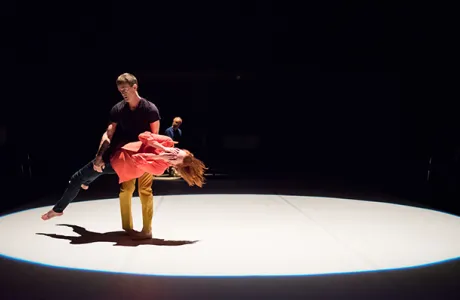
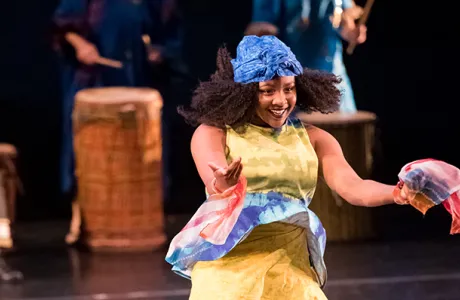
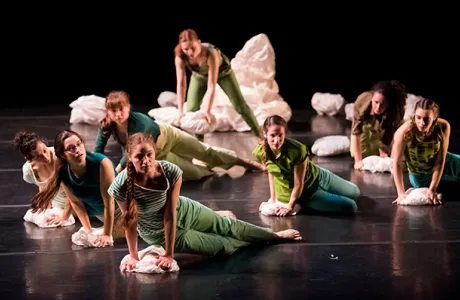
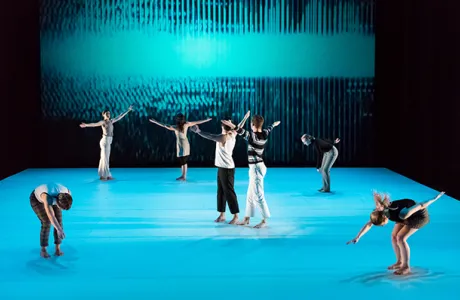
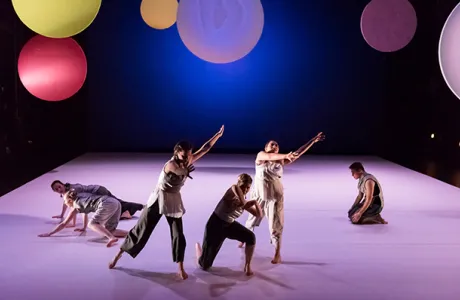
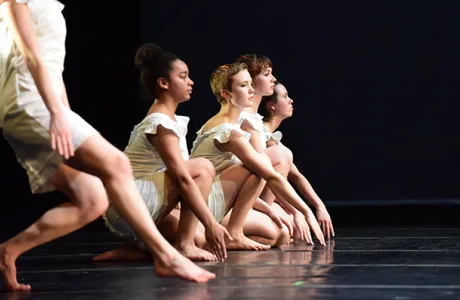
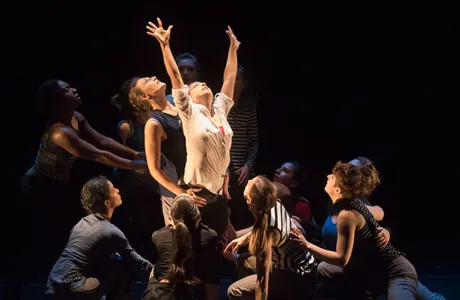
Faculty
Teaching Fellows & Lecturers
In the Studio
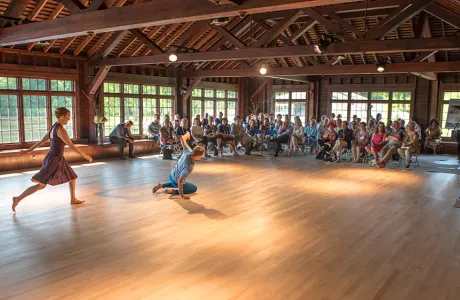
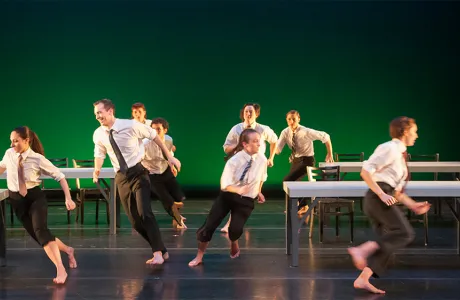
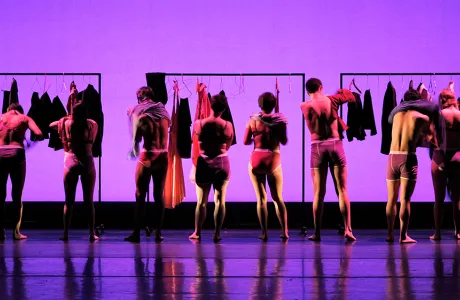
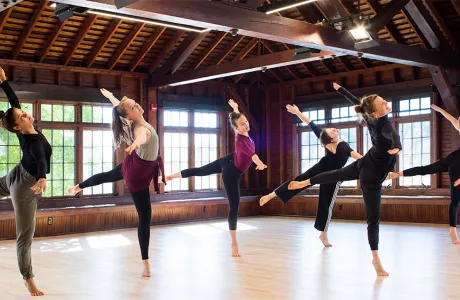
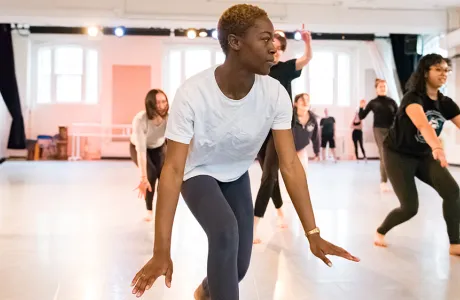
Master of Fine Arts in Dance
The Master of Fine Arts in Dance is designed for students who prefer to work in an intimate environment with a small group of peers in order to maximize the growth and development of their interests and potential.

Sign Up for Our Newsletters
Contact Department of Dance
47 Belmont Avenue
Smith College
Northampton, MA 01063
Phone: 413-585-3232 Email: dance@smith.edu
Administrative Coordinator: Katherine Kain
